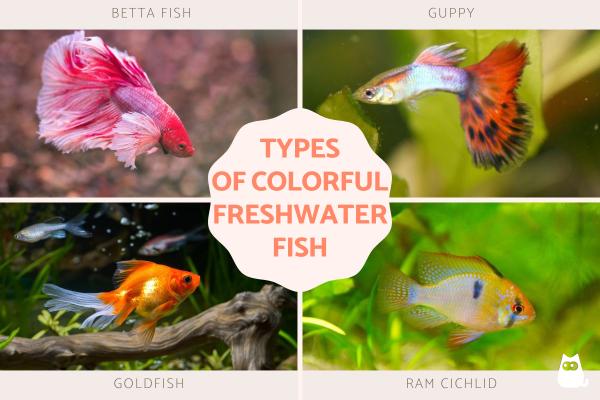
Generally speaking, the diversity of fish colors and patterns is greater with marine fish than freshwater fish. This doesn't mean there are no colorful freshwater fish. In fact, some of the most popular freshwater community fish are the most colorful in the world. It does mean you might need to spend some more time looking for them. Freshwater fish represent an expression the rich biodiversity that inhabits lakes, rivers and lagoons across the world. You can have a reflection of this biodiversity at home by caring for fish in a fish tank.
Colorful community fish can help to provide a lot of beauty and peace to your home. AnimalWised shares 10 colorful fresh fish for the aquarium with photos so you can see what options you might have.
Betta fish (Betta splendens)
This species is native to Southeast Asia. Although its wild form features inconspicuous colors and short fins, it has been selectively bred in captivity to develop a wide variety of bright colors and striking shapes.
Also known as the Siamese fighting fish, it is one of the most popular colorful aquarium fish worldwide. Despite its popularity in home fish tanks, in the wild this species is considered vulnerable by the International Union for Conservation of Nature (IUCN). This is mainly due to pollution and habitat loss.
Betta fish are known for their aggression, especially between competing males of the same species. This means that not all combinations of community fish will fare well with a betta in the mix. To help determine whether a betta fish is a good option for your fish tank, check out our article on compatible tank mates for betta fish.
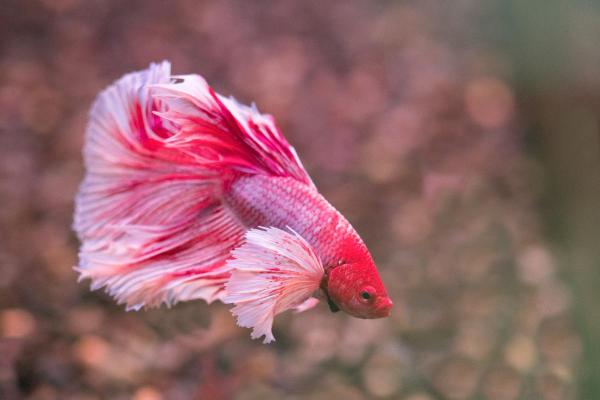
Guppy (Poecilia reticulata)
The guppy is a tropical fish native to northeastern South America, present in countries such as Venezuela, Trinidad and Barbados. Their popularity as aquarium fish has led to them being present in home fish tanks around the world, but also they have been introduced to various waters in the US, Europe and Australia. This is because of captive fish being released and programs where guppies are used to control mosquito and other insect populations.
Guppies are distinguished by their remarkable coloration, especially in males. They present varied patterns influenced by hormonal and environmental factors. Females have more subdued colors. This sexual dimorphism and their adaptability have favored intense selective breeding, generating multiple varieties. Learn more about these different guppy morphs with our guide to the different types of guppies.
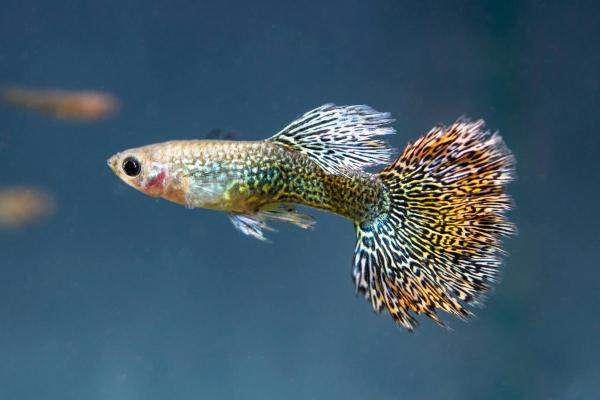
Molly (Poecilia sphenops)
Also known as a Mexican molly, the molly is a freshwater fish native to Mexico, Guatemala and Honduras. It was previously thought to have a wider distribution, extending as far as South America. We now know these records correspond to other species in the same group.
Thanks to its popularity, the molly has been introduced to other regions. Again, some records outside its natural habitat may belong to similar species. This species has been crossed with others form the same genus to create ornamental specimens, such as P. latipinna and P. velifera. Females are slightly larger than males and several color varieties have been obtained.
Mexican mollies are only one of the colorful freshwater fish for aquariums which have good compatibility as tank mates for angelfish.
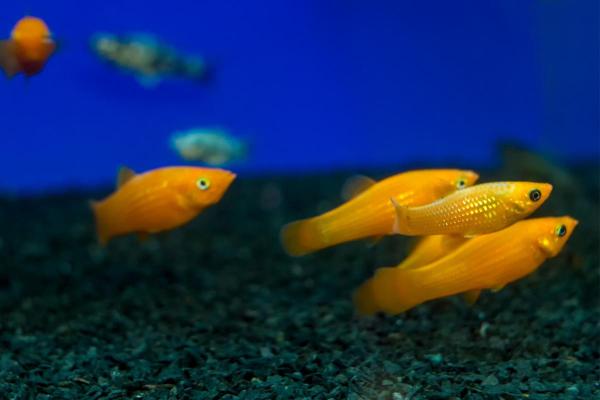
Southern platyfish (Xiphophorus maculatus)
Also known as the common platy or moonfish, the southern platyfish is a colorful freshwater fish native to the warm and calm regions of eastern Mexico and northern Belize. It is small and exhibits slight sexual dimorphism, with males having a more pointed caudal fin. Females possess a fan-shaped anal fin.
In the wild, the platyfish color is subtle, but multiple colorful variants have been bred in captivity. This makes it a very striking freshwater fish. It feeds on plants and small invertebrates.
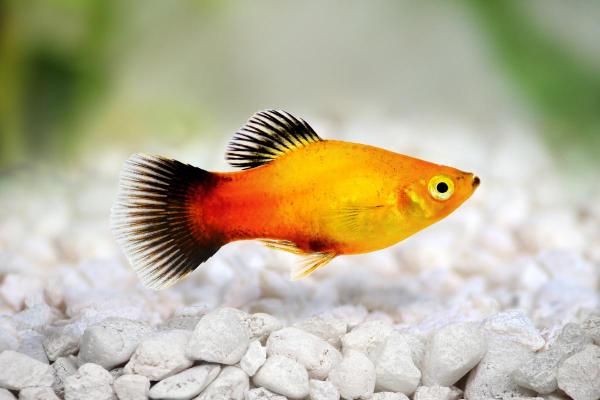
Green swordtail (Xiphophorus hellerii)
This species is native to Central America, from Veracruz to northwestern Honduras. Green swordtail males grow up to about 5.52 (14 cm) and have a characteristic fin on their underside which looks like a sword, hence their name. While females are somewhat larger, they lack this fin extension.
While the natural color of green swordtails is olive green with a red or brown line on the sides, there are various different color cultivars bred in captivity. It is omnivorous and inhabits fast-flowing rivers and streams with abundant vegetation. It has become an invasive species after being introduced to other countries, threatening local ecosystems due to its high reproductive capacity.

Neon tetra (Paracheirodon innesi)
The neon tetra is a small tropical freshwater fish native to the Amazonian streams of Brazil, Colombia and Peru. It is famous for its striking coloration, which includes a bright blue and a red stripe. This allows it to stand out in dark waters, making it a very popular species in aquariums.
The body of the neon tetra is partially transparent, except for the iridescent stripes which vary depending on the light. These stripes turn gray during rest and regain their brightness when activated. It is a very small schooling fish and exhibits slight sexual dimorphism, with females being slightly more rounded.
Due to breeding in captivity, there are many different types of tetra fish you can keep in your freshwater aquariums.
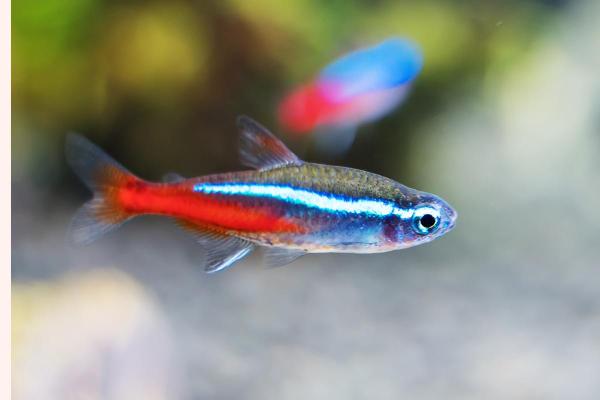
Boeseman's rainbowfish (Melanotaenia boesemani)
The Boeseman's rainbowfish is endemic to the lakes of West Papua in Indonesia. It is known for its intense colors and peaceful nature, making it popular in aquariums. Its body features distinctive coloration, with bluish or purple hues on the front and reddish hues on the back.
These fish can grow up to 4" (10 cm) in length if kept in good conditions. Its color varies depending on mood and lighting, appearing most vibrant at night. It lives in slightly alkaline waters and requires both hiding places and open areas. It is currently in danger of extinction due to habitat degradation, invasive species and climate change.
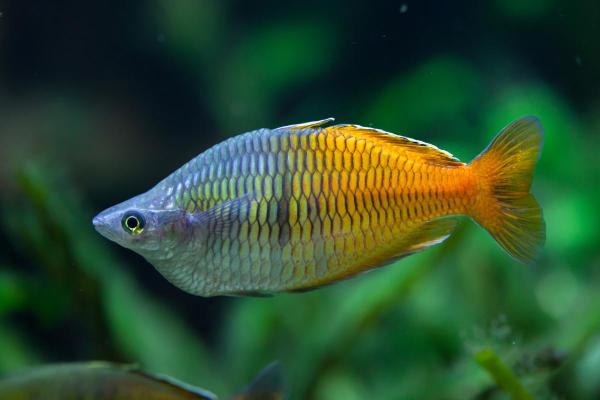
Ram cichlid (Mikrogeophagus ramirezi)
Also known as the blue ram, German blue ram, Asian ram, Ramirezi or simply ram, this colorful freshwater fish species is native to the Orinoco River basin in Venezuela and Colombia. It is a colorful freshwater fish highly valued by aquarists for its behavior and attractive appearance. It has been the subject of scientific research due to its interesting behavioral patterns.
Males are usually larger and have longer dorsal fins, although some females may also display this characteristic due to selective breeding. During spawning, females display a pinkish or reddish hue on the abdomen and distinctive bluish details in a spot near the dorsal fin. They do not usually exceed 1.5" (4 cm) in length.
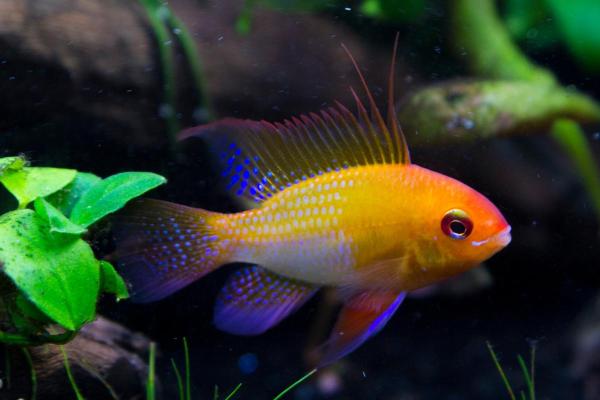
Blue discus (Symphysodon aequifasciatus)
Confusingly, the blue discus is also commonly known as the brown discus. This is because individuals have different prominent colorations, but all are considered colorful freshwater fish for fish tanks. It prefers to inhabit areas with calm waters, such as floodplains and inundated forests. It can also be found in blackwater, clearwater or fast-flowing rivers with low sediment content.
In its natural environment, it can measure up to 6" (15 cm), although in captivity some specimens reach 9" (23 cm). It is a highly prized species in aquariums for its striking coloration and calm demeanor.
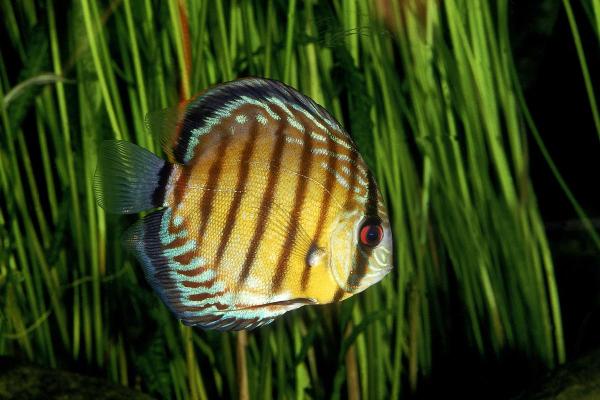
Goldfish (Carassius auratus)
The goldish is probably the most popular freshwater aquarium fish in the world. It is native to China and belongs to the carp family. Widely used in home aquariums, it has been selectively bred for a long time. This has resulted in numerous varieties with different shapes, sizes, and colors.
Although in the wild it can reach up to 8.5" (22 cm), some specimens grow much larger, especially in ponds or lakes. They can reach over 16" (40 cm) and several pounds in weight. In some regions where it has been introduced, its release into the wild has generated ecological problems as it has become an invasive species.
Learn more about the best tank mates for this species with our guide to which fish can live with goldfish.
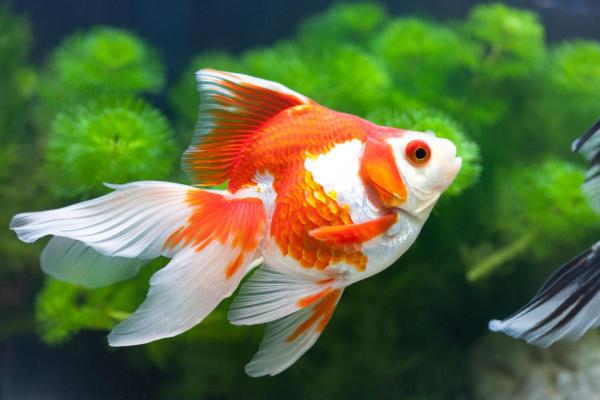
If you want to read similar articles to Colorful Freshwater Fish for the Aquarium, we recommend you visit our Comparisons category.
- Animal Diversity Web. (2020).
https://animaldiversity.org/ - IUCN. (2024). The IUCN Red List of Threatened Species. Version 2024-2.
https://www.iucnredlist.org